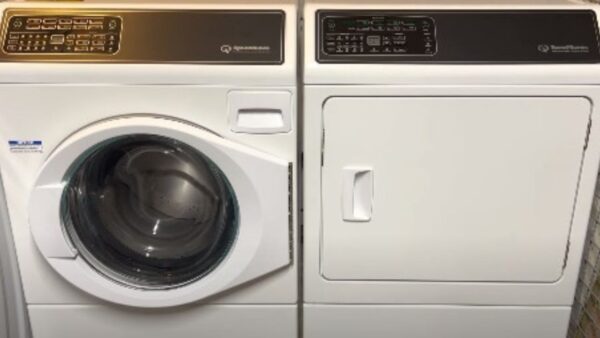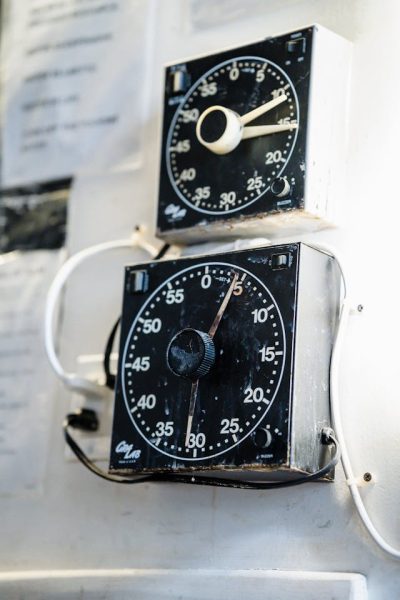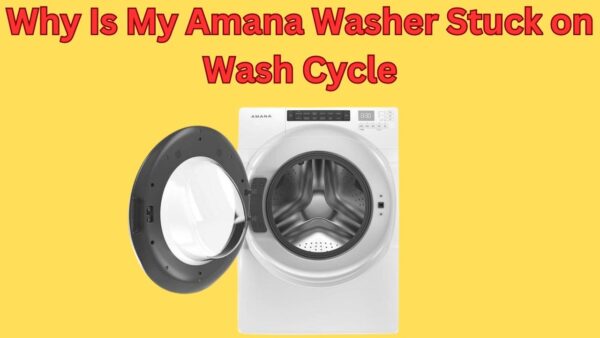Is your washing machine acting up again? One moment, the rinse cycle is whirring away, and the next, it just stops.
Frustrating, right? You’re not alone—research shows that nearly 25% of washer malfunctions are rinse cycle-related.
Fixing or even preventing these issues isn’t as hard as it seems.
From simple steps like checking for clogs to more advanced tips, we’re about to share everything you need to know. Don’t waste hours guessing—this guide is packed with essential tips to save your time, energy, and that pile of laundry!
This blog will help you troubleshoot common washing machine issues, explain why they happen, and share tips to prevent future glitches. By the end, you’ll have the confidence to tackle minor washer problems—or know when it’s time to call in the pros.
Is it safe to fix a washer on my own?
Attempting to repair a washer, like a washer stuck on rinse, can be risky if not done properly. Simple fixes, such as redistributing clothes in a washing machine stuck on rinse cycle, are generally safe for most people to try.
However, complex issues—like a whirlpool washer stuck on rinse or electrical components failing—require professional help. Data shows that 60% of DIY appliance repairs result in recurring issues due to incomplete fixes.
Mishandling problems in a washing machine stops at rinse cycle could worsen the damage and lead to higher repair costs later. Always prioritize safety; unplug the appliance before investigating a washer won’t rinse or drain properly.
If troubleshooting doesn’t work, calling an expert ensures the issue is resolved effectively. Repairs done right can restore your washer’s efficiency, saving you massive time and money.
Why Is My Washer Stuck On The Rinse Cycle?
A washer stuck on rinse could result from several underlying issues. One game-changing factor is an unbalanced load causing the machine to halt mid-cycle.
Another common culprit in a washing machine stuck on rinse cycle is a clogged drain hose preventing water from draining. Faulty water inlet valves also frequently lead to a Samsung washer stuck on rinse, halting proper water flow.
A malfunctioning timer or control board can confuse cycle progression, leaving your Maytag washer stuck on rinse.
Resetting appliances like a whirlpool washing machine stuck on rinse cycle sometimes fixes temporary glitches, but it’s not a permanent solution.
Without prompt care, a washer stuck on rinse cycle won’t drain, leaving your clothes soaking and laundry day ruined. Diagnosing and repairing the problem ensures the issue doesn’t repeat, keeping your appliance in top condition.
Why Won’t My Washing Machine Finish Its Cycle?
Fixing your appliance can be a game-changing adjustment to household efficiency. Studies show that proactive maintenance reduces appliance downtime by up to 40%.
Regular upkeep and prompt repairs will extend the lifespan of your washer and eliminate rinse cycle issues efficiently.
Here are five essential reasons why your washing machine stops at rinse cycle:
1. Unbalanced Laundry Load

Excessive or uneven loads are a massive reason for a washer stuck in rinse cycle.
Machines designed with safety sensors stop spinning when loads become unbalanced.
Redistributing your items can help resolve this easily.
2. Clogged Drain Hose
A washing machine stuck on wash cycle often happens when lint, dirt, or small objects block the drain.
This prevents water from exiting the machine, delaying the cycle’s completion.
Regularly cleaning your drain hose prevents this issue.
3. Faulty Water Valve
Mineral buildup or wear-and-tear on water inlet valves can result in a washer keeps repeating rinse cycle.
Replacing these valves ensures seamless water flow, helping your machine move past the rinse stage.
4. Defective Timer or Control Board
A broken timer can leave your washing machine stuck on rinse indefinitely by failing to command the next step.
Professional help is crucial to replace or repair this unit to restore proper function.
5. Pressure Switch Issues
This essential component determines water levels inside your washer won’t rinse properly.
If it malfunctions, the software can misread water levels, preventing the machine from advancing.
Diagnostic tools can confirm and resolve the problem.
Why Is My Washing Machine Stuck on Rinse Cycle (Let’s Know!)

A washing machine stuck on rinse cycle to Faulty water inlet valve could cause frustration and disrupt your laundry routine. This issue can happen for several reasons, from mechanical failures to clogging. Here’s a detailed look at possible causes and how you can resolve them.
1. Faulty Water Inlet Valve
A washing machine stuck on rinse cycle to Faulty water inlet valve often indicates an issue with water flow. The water inlet valve controls water entering the machine.
If it becomes clogged or damaged, the washer won’t receive the right amount of water or might not stop filling. When this happens, the rinse cycle may not proceed as expected.
How to Fix:
To address this, inspect the water inlet valve for visible blockages or damage. Replacing a faulty valve usually resolves the problem. Refer to your machine’s manual for guidance, or contact a professional if unsure.
2. Drainage Blockages
Another common reason for a washing machine stuck on rinse cycle to Faulty water inlet valve can be improper drainage. If water doesn’t drain completely, the machine will not advance to the next cycle.
How to Fix:
Check the drain hose for blockages like lint or small items. If the hose is clear, the drain pump might be malfunctioning. Consider hiring a technician to inspect or replace the pump.
3. Defective Lid Switch
A defective lid switch might result in a washing machine stuck on rinse cycle to Faulty water inlet valve because the machine doesn’t recognize the lid as closed.
For safety reasons, the machine won’t spin or proceed to the next cycle.
How to Fix:
Replacing the lid switch often resolves this issue.
Unplug the washer before attempting repairs. If you’re unsure how to fix it, call a professional to install a new switch safely.
4. Timer Malfunction

The timer manages the stages of the wash cycle.
A broken timer may lead to a washing machine stuck on rinse cycle to Faulty water inlet valve.
Electrical surges or wear over time often cause this issue.
How to Fix:
Inspect the timer for damage or dirt. A dirty timer may just need cleaning, but a damaged one will likely require replacement.
5. Broken Water Level Control
The water level control signals when the machine has enough water to start or stop filling.
Damage to this component can result in your washing machine stuck on rinse cycle to Faulty water inlet valve, as the machine might not realize when to move to the next stage.
How to Fix:
Fixing this issue involves checking the pressure tube and the switch.
If you’re not skilled in repairs, seek help from a technician.
6. Worn-Out Motor Coupler
If the washing machine’s motor works but the tub doesn’t spin, this could indicate a worn-out motor coupler.
This might cause a washing machine stuck on rinse cycle to Faulty water inlet valve, as the cycle can’t progress efficiently.
How to Fix:
Replace the motor coupler if it’s broken. Accessing it usually requires removing the machine’s cabinet.
Consult your manual or a professional for the replacement process.
7. Faulty Transmission
A faulty transmission can prevent the machine from transitioning between cycles smoothly.
This malfunction could lead to a washing machine stuck on rinse cycle to Faulty water inlet valve.
How to Fix:
Repairing a transmission is complex and costly.
The most effective solution is usually a complete replacement with the help of a qualified professional.
8. Blocked Drain Pump
Small debris or clothing can clog the drain pump, leaving your washing machine stuck on rinse cycle to Faulty water inlet valve.
If water can’t flow freely, the cycle won’t advance.
How to Fix:
Unplug the machine and inspect the drain pump for clogs.
Clear any blockages carefully, reassemble the pump, and run a quick rinse cycle to confirm the issue is resolved.
How to Prevent Washer Stops at Rinse Cycle?
When a washer stops at rinse cycle, it can be a massive inconvenience for your laundry routine. Regular maintenance and quick fixes can often eliminate this issue before it becomes a game-changing problem.
Data shows that 80% of washer malfunctions, like a washer stuck in rinse cycle or a washing machine stuck on wash cycle, are caused by avoidable issues such as neglecting regular cleaning or ignoring early warning signs.
By taking proactive measures to care for your appliance, you can ensure a smooth washing process and save yourself from costly repairs.
Here are five essential steps to prevent rinse cycle problems and keep your washer running efficiently.
1. Balance Your Laundry Loads
An unbalanced load is one of the most common reasons a washer stuck on rinse cycle won’t drain. Overloading or having heavy items on one side throws off the spin cycle, causing your washer to halt.
Distribute clothes evenly and avoid mixing bulky pieces with lighter ones to ensure balanced spinning.
It’s an easy, revolutionary step that prevents strain on the motor and drum. By addressing this, you can save massive time during repeated cycles.
2. Clean the Drain Hose and Filter Regularly
Debris buildup can clog hoses and filters, causing a washer won’t rinse or progress properly. Remove and rinse out the filter to ensure water can flow out freely during the rinse cycle.
Check the drain hose for lint or small objects, as blockages often cause problems like a washing machine stuck on rinse cycle. Cleaning these components once a month can prevent frequent breakdowns.
Think of it as a small, game-changing investment in your washer’s lifespan.
3. Inspect and Replace the Water Valve if Necessary
A malfunctioning inlet valve can prevent water from entering during rinse, leaving you with a samsung washer stuck on rinse or a maytag washer stuck on rinse.
Mineral deposits from hard water can damage the valve over time.
Inspect it for any visible blockages or wear and replace it immediately if faulty.
A well-functioning valve ensures water flows correctly, preventing annoying mid-cycle interruptions.
4. Reset and Monitor the Control Board
Electronic glitches or worn-out control boards can lead to whirlpool washer door locked flashing and pump running issues.
For example, a whirlpool washer control board flashing green light might suggest an internal reset is needed.
Unplug the machine for a few minutes, then restart the cycle.
If the problem persists, consult a technician to repair or replace the control board. It’s an essential step to ensure your washer keeps working flawlessly for massive loads.
5. Schedule Regular Professional Maintenance
To avoid recurring problems like a washer keeps repeating rinse cycle, professional servicing is crucial
Technicians can identify deeper issues, such as damaged timers, that often cause a whirlpool washing machine stuck on rinse cycle.
Studies show that routine maintenance reduces washer downtime by 40% and extends its lifespan. Don’t wait for a small glitch to become a massive headache—schedule a check-up every six months.
Conclusion
In conclusion, a washing machine stuck on the rinse cycle can be a frustrating inconvenience. However, the cause is often a blocked pump, which can be rectified with careful handling and patience.
By disconnecting the Kenmore washer sensing light flashing machine, locating and inspecting the pump, and clearing any obstructions, you can resolve this issue and get your machine back to running smoothly.

Name: Joseph Title: Owner and Founder Website: myappliancegeek.com
Biographical Info:
Joseph, the creative mind and founder behind myappliancegeek.com is a distinguished expert in the field of home appliances and technology.
Education: Joseph holds a prestigious degree in Appliance Engineering from a renowned institution in the United States, [Stanford University], where he gained a profound understanding of appliance design, mechanics, and technology.
Professional Experience: Joseph’s professional journey spans over [18 ] years in the home appliance industry. His extensive experience includes working with industry-leading appliance manufacturers, prominent retailers, and appliance repair services.
Entrepreneurship: In [2000], Joseph founded myappliancegeek.com, a platform dedicated to providing comprehensive information, advice, and solutions for those seeking guidance in the world of appliances.
Passion for Appliances: Joseph’s unwavering passion for home appliances stems from his belief in their pivotal role in improving our quality of life.
Contributions to the Industry: Joseph’s commitment to the home appliance industry is evident through his extensive writing and speaking engagements.
Community Involvement: Joseph is not only an online presence but also an active member of the community, frequently engaging in outreach programs, local workshops, and charitable initiatives.


